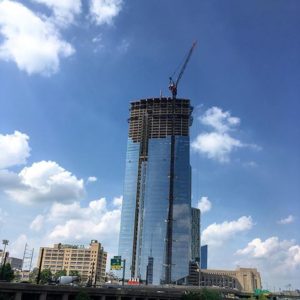Recent City of Philadelphia Contractor Safety Requirements: Can They Affect Environmental Projects?
From the desk of David S. Coyne, Principal, Qualified Environmental Professional

Photo Courtesy of New Age Realty Group, Inc.
On June 5, 2013, a building collapse occurred during a demolition project at the intersection of 22nd and Market Streets in Philadelphia, tragically killing six people and injuring 14 others. The City of Philadelphia’s immediate investigation into the cause of the collapse revealed startling lapses in safety measures and project planning by the demolition contractor, and identified the need for immediate changes to permitting and inspection procedures for demolition projects in the City. Less than one week after the collapse, the City issued a set of new permitting requirements that emphasized increased safety elements, project planning, worker training and closer monitoring and inspections of work-in-progress.
Subsequently, a wholesale re-evaluation of the procedures governing construction and demolition was performed by City administrators, in a wide-ranging effort that took nearly two years to complete. The new measures were largely the responsibility of the Department of Licenses and Inspection (L&I), and include a revamped licensing program for demolition contractors, the incorporation of extensive OSHA and building code training requirements for site workers and supervisors, new Site Safety Manager designations and responsibilities, and more robust insurance coverage limits. The new requirements took effect in November 2015. City-based contractors have reported that the first half of 2016 has been a period of adjustment for many firms specializing in site redevelopment work, as the new requirements trickle down through contractor-subcontractor project arrangements.
Environmental cleanup projects, often closely tied to demolition and site redevelopment activities, have not been immune to these changes.
Knowing the new rules, and making sure that the selected contractors meet (or are even aware of) the current requirements, has been a challenge according to some project coordinators. Few may have expected the new rules to apply to tank contractors, for instance, but as licensed contractors operating in the City of Philadelphia, the L&I Contractor License requirements now must include the designation of a supervisory employee who has attended OSHA 30-Hour Safety Training, in addition to the federally-imposed worker safety training required under OSHA (29 CFR Part 1926). These safety requirements are in addition to the existing criteria needed to obtain a construction permit and its prerequisite approvals, which were in place prior to the 2013 building collapse. Consistent with state regulations, a DEP Tank Contractor Certification must accompany the permit application for any regulated storage tanks.
Although not a new requirement, the issuance of a Demolition Permit is contingent on the completion of an Asbestos Inspection Report (AIR) for any building constructed before December 1980, excepting residential buildings with three or fewer dwelling units. However, the new criteria for demolition permits, and more specifically the new licensure requirements for demolition contractors, have affected project timelines in 2016 while companies have scrambled to meet the new contractor qualifications.
Overall, the industry has recognized the need for the increased safety provisions, accepting them as not just a necessary element of Philadelphia-based work, but as an additional protection against future workplace accidents and liability. For environmental consultants and contractors, the new requirements have forced greater selectiveness in qualifying firms and a new awareness of proper safety measures and project planning. If the difficult lessons of June 5, 2013 can bear such fruit through the prevention of future accidents, this adjustment period will be well worth the effort.